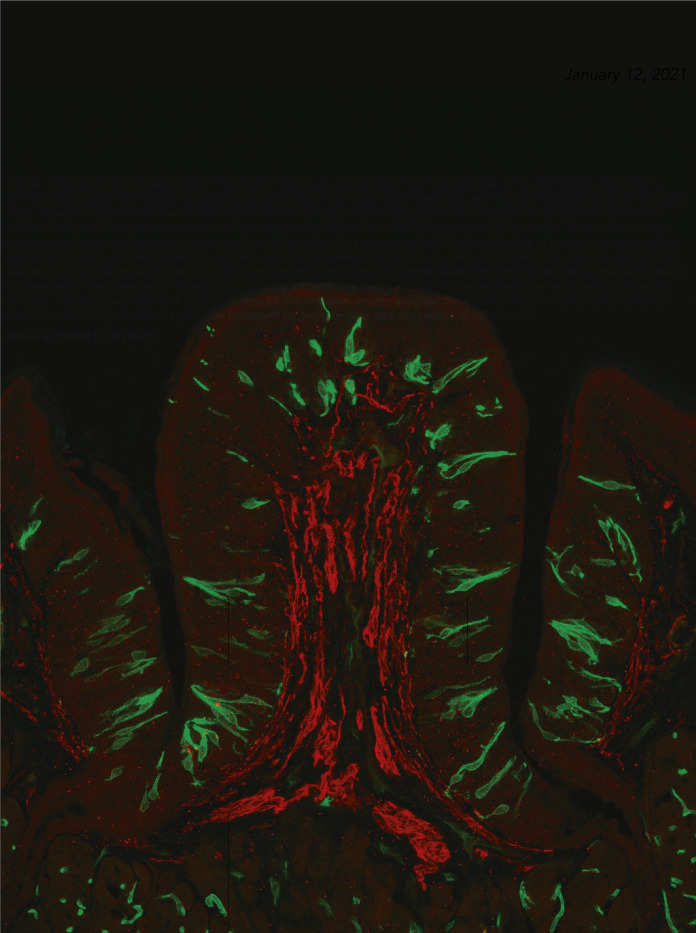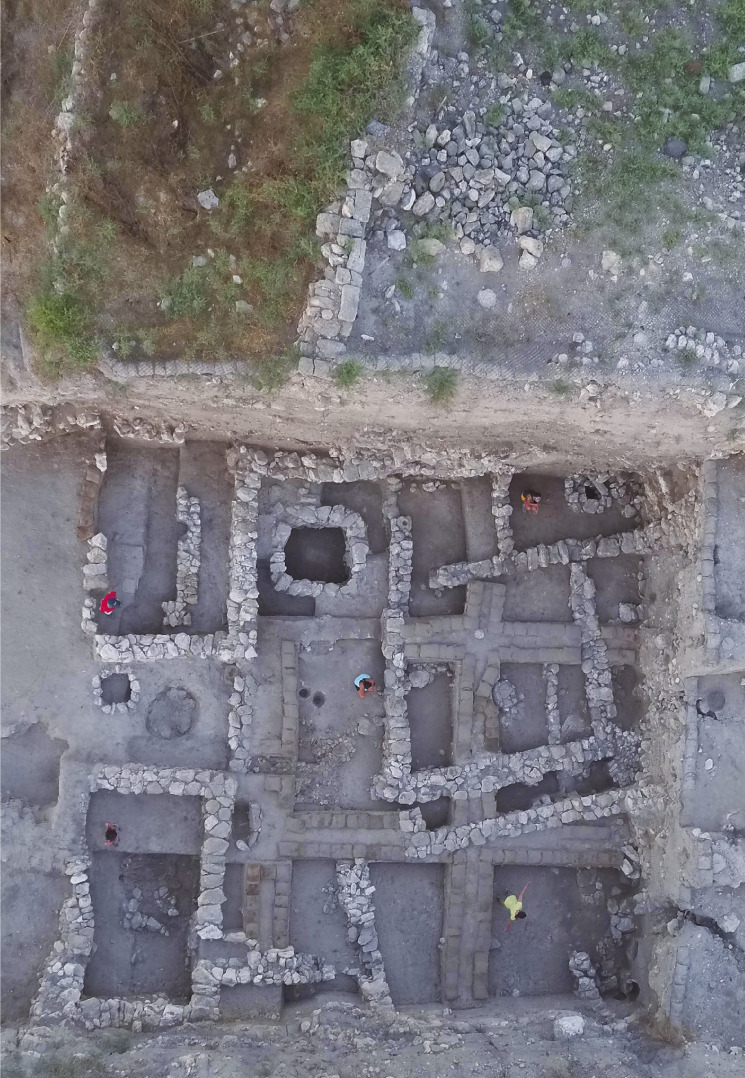NEUROSCIENCE
Exogenous R-spondin promotes taste cell generation in the absence of innervation.
Signaling protein regenerates taste cells, maintains taste tissue homeostasis in mice
Like all cells, the 50 to 100 taste cells in the human taste bud age and lose their integrity over time. First shown more than a century ago, signals from distant, gustatory ganglion neurons tell adult taste stem cells when to differentiate and replenish taste buds; however, researchers have yet to determine exactly which neuron-supplied factors mediate the production of differentiated taste cells. Taking advantage of a recently published RNAseq data set of mouse gustatory neurons, Xiaoli Lin et al. use data mining and in situ hybridization to reveal that R-spondin-2—a member of the R-spondin family of proteins involved in Wnt signaling and stem cell differentiation—is predominantly expressed in gustatory neurons. To support their findings, the authors use an in vivo mouse model to demonstrate that exogenous R-spondin promotes taste stem cell differentiation and taste tissue homeostasis in the absence of the neuronal signaling and that R-spondin is required to produce taste cells in ex vivo organoid cultures. The study argues that R-spondin-2 may be the unknown neuron-supplied factor that maintains taste cells throughout the human lifespan, as well as a potential treatment for patients who lose their sense of taste. — T.J.
PNAS e2001833118 (2021)
EARTH, ATMOSPHERIC, AND PLANETARY SCIENCES
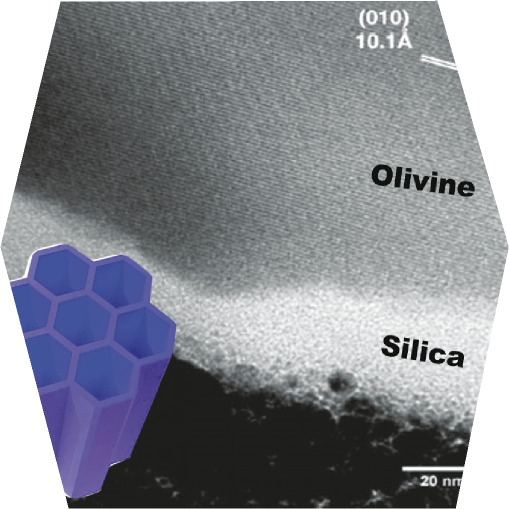
Electron micrograph of precipitated, nominally amorphous silica layer resulting from olivine dissolution, which is suggested to contain mesoporous regions (purple insert) capable of catalyzing prebiotic organic reactions.
Porous silica, peptide feedback as a path to polymerization on prebiotic Earth
In Earth’s ancient past, interactions between small organic molecules in aqueous environments gave rise to the large organic structural assemblies that comprise living organisms. Today, technologies use organic structure directing agents (SDA) to synthesize catalysts such as zeolites and mesoporous silicas, with specific pore and channel configurations engineered to control industrial-scale processes. Alexandra Navrotsky et al. propose that analogous silica-organic interactions, structure direction, and catalysis may have helped to synthesize complex organic molecules on the early Earth from prebiotic small organic molecules. The authors describe a molecular scale, synergistic process between organic species in aqueous solution and silica formed from mineral dissolution, which could lead to structure direction and the formation of catalytically active, reprecipitated zeolitic and/or mesoporous silica. According to the authors, this process would constitute a self-sustaining feedback loop of reactions between functional, porous silica structures and small peptides and fatty acids, spurring the formation of larger peptides that lead to proteins and drive other organic reactions. Finally, the authors provide a series of outstanding questions and propose experiments and computational analyses to test the hypothesis. — T.J.
PNAS e2021117118 (2021)
ANTHROPOLOGY
Excavation of Megiddo (Area K). Image credit: the Meggido Expedition.
Food trade with South Asia revealed by Near East food remains
Long-distance trade has had a significant impact on cuisines worldwide, and although long-distance food trade is well-documented since the Roman era, the preceding history of food trade and subsequent cuisine evolution in Europe and Asia is unclear. Ashley Scott et al. analyzed remains of food preserved in the dental calculus of 16 people who lived in the Southern Levant during the 2nd millennium BCE to ascertain their diet. The authors found expected staple foods such as cereals, sesame, and dates, and also evidence of exotic foods including soybean, banana, and turmeric. The results suggest that sesame had become established as a crop in the region by the 2nd millennium BCE and that bananas, for which little archaeological evidence is preserved, had made an appearance in the region. In the case of turmeric, the results push the earliest known appearance in the Mediterranean back by centuries; in the case of soybeans, the earliest known appearance is pushed back by millennia. According to the authors, the results suggest that a robust trade network had developed between the Near East and South Asia by the 2nd millennium BCE and offer physical evidence to support textual and other lines of evidence used to reconstruct past diets and agricultural expansions in prehistory. — P.G.
PNAS e2014956117 (2020)
APPLIED PHYSICAL SCIENCES
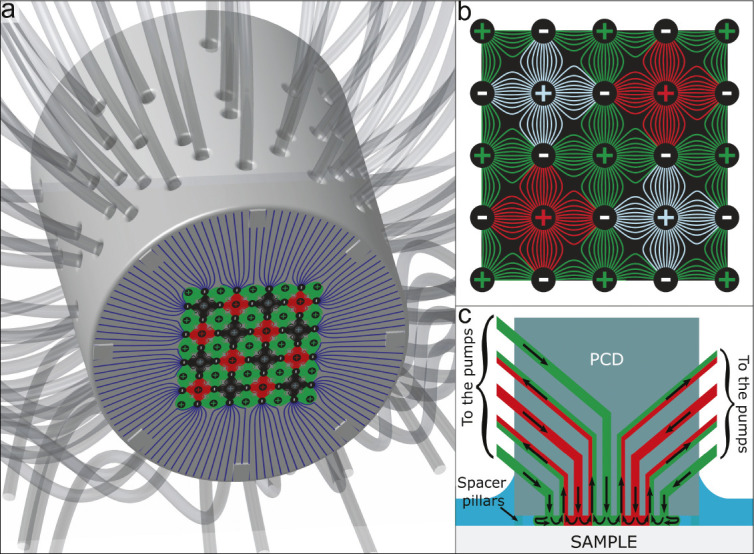
The pixelated chemical display is a versatile liquid handling system.
Pixelated chemical displays offer versatile liquid handling
Automated liquid handling (ALH) systems efficiently deposit small volumes of liquid using multiple pipette heads simultaneously. Despite their widespread use in academic and industrial laboratories, most existing ALH systems are simply robots that perform the human pipetting movement, and a growing number of applications require fluid manipulation beyond what is currently possible. To address this need, Pierre-Alexandre Goyette et al. developed the pixelated chemical display (PCD)—a versatile liquid handling system based on open-space microfluidics. The researchers used 3D printing to fabricate PCDs that could simultaneously project 144 pixels—independent reagent streams—onto surfaces, providing very stable and regular flow patterns. The streams could be co-localized above a surface and reconfigured over time with precise spatiotemporal control. The authors used PCDs to deposit a precise silver pattern on thin plastic film. Unlike previously developed open-space microfluidic devices, PCDs are massively parallel, can be scaled to any size, and can operate over dry surfaces, not just immersed surfaces. According to the authors, PCDs are compatible with a wide range of solvents and acids and may have broad applications in biology, chemistry, and materials science. — J.W.
PNAS e2019248118 (2021)
BIOPHYSICS AND COMPUTATIONAL BIOLOGY
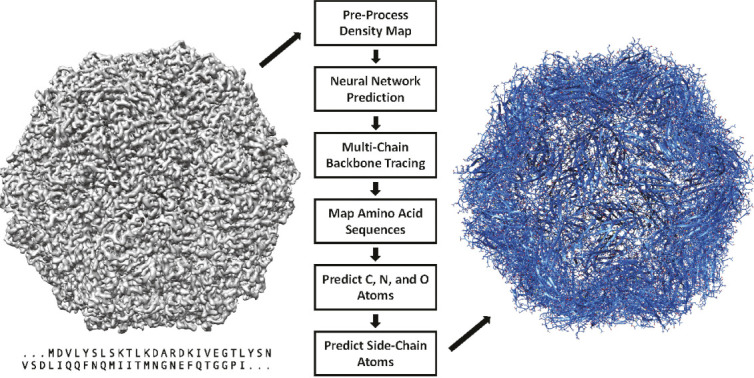
Diagram shows DeepTracer’s pipeline for determining protein structure models.
Fast, fully automated software constructs accurate models of protein structure
Determining the structures of protein complexes can provide insights into their functions and inform the development of vaccines and therapies. Cryo-electron microscopy (cryo-EM) provides near-atomic resolution 3D maps of large molecules, but deriving all-atom structures of protein complexes from cryo-EM data has been challenging. To accomplish this feat, Jonas Pfab et al. developed DeepTracer—a fast, accurate, fully automated software tool that leverages a tailored deep convolutional neural network. The authors applied this technique to a set of 476 cryo-EM maps and compared its performance to that of Phenix—the state-of-the-art cryo-EM model determination method. Deposited model structures available in EMDataResource served as the ground truth. DeepTracer outperformed Phenix on every metric calculated. DeepTracer created more complete protein structures, achieving 77% coverage of amino acid residues, whereas Phenix correctly determined only 46% of the residues. DeepTracer also achieved greater spatial accuracy, predicted amino acid types with greater accuracy (50% versus 12%), and connected residues better. The authors obtained similar results when comparing the performance of the two methods at deriving models from 62 coronavirus-related cryo-EM maps. DeepTracer also modeled large protein complexes exceptionally fast, tracing approximately 60,000 residues within two hours. According to the authors, DeepTracer can help to accelerate the scientific discovery process. — J.W.
PNAS e2017525118 (2021)
EVOLUTION
Identifying uniquely human features of the brain
In human evolution, researchers have theorized that adaptations which altered regulatory function underlie the emergence of uniquely human traits, such as the expansion of our cerebral cortex. Despite keen interest, finding these key branching points between humans and other primates has remained technically challenging. Severin Uebbing, Jake Gockley, et al. use massively parallel reporter assays to probe the effects of more than 32,000 human-specific genetic substitutions on regulatory function in neural stem cells. Focusing on two classes of regulatory elements thought to exhibit novel regulatory activities in humans—human accelerated regions (HARs) and human gain enhancers (HGEs)—the authors find that more than 30% of active HARs and HGEs differ functionally between humans and chimpanzees. Within HARs and HGEs that exhibit human-specific regulatory activity, the study identifies more than 400 specific sequence changes that influence each other in both additive and non-additive ways to alter regulatory function and potentially shape human evolution. The findings both reveal new details about how evolutionary innovations impact enhancer function and offer new candidates to study the emergence of uniquely human neural traits, according to the authors. — T.J.
PNAS e2007049118 (2021)
GENETICS
Two gene-edited piglets with a male genotype and female phenotype.
Sex determination in pigs
Although the sex-determining region of the Y chromosome, or SRY, is thought to regulate development of male mammals, the mechanism of the region is unknown, as is whether other regions of the chromosome also contribute to sex characteristics. Stefanie Kurtz et al. utilized CRISPR-Cas gene editing to knock out a central group within SRY in pig genomes, causing downstream mutation effects. The knockout resulted in pigs that were genetically male, with a Y chromosome, but physiologically female; although, by 9 months of age the sex organs were significantly smaller in the gene-edited pigs than in control females of a similar age, leading to sterility in gene-edited pigs. Incomplete female genitalia development in the XY pigs, the researchers write, demonstrates the key role of a second X chromosome in normal development. The results provide a possible alternative to surgical castration in commercial pig production to prevent boar taint and, owing to the genetic, physiological, and anatomical similarities between pigs and humans, provide a large animal model for investigating mammalian sex determination and sex development disorders. According to the authors, the results highlight the role of the central group of the SRY in male sex determination in pigs. — P.G.
PNAS e2008743118 (2021)
APPLIED PHYSICAL SCIENCES
Open-mindedness of individuals can, as a model underscores using data from Twitter, make a group both less likely to become polarized and more resistant to the influence of political campaigns. Image credit: Shutterstock/Sketchy Bytes.
Model captures how polarization emerges on social media during political campaigns
Posted on December 25, 2020
Stephen Ornes
In recent years, social media platforms have become hotbeds of political discourse—as well as rancorous division. In a recent paper in Physical Review X, researchers unveil a new mathematical model that demonstrates how a combination of campaign information and peer influence give rise to partisan echo chambers. Continue Reading⇒



